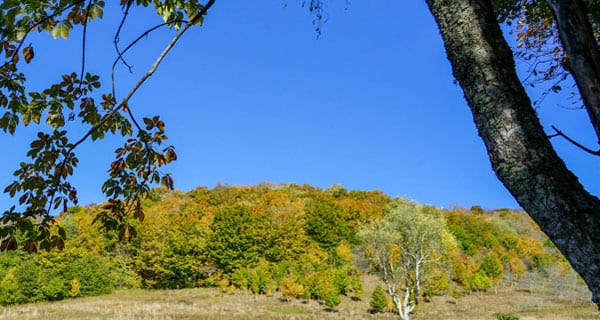
The Roan Mountain Gateway is prominent in views from Round Bald and Jane Bald, iconic locations along the Appalachian National Scenic Trail in the Highlands of Roan. The land contains high elevation habitat, including restored habitat for neo-tropical migratory Golden-winged Warblers and other species, as well as headwater tributaries that flow into local trout streams.
“This is a beautiful tract of land within the Highlands of the Roan that can now be enjoyed by all and seen from scenic viewpoints along the Appalachian Trail,” says Jen Barnhart, Appalachian District Ranger with Pisgah National Forest. “We are proud to be the stewards of this land among a majestic part of the Pisgah National Forest that was secured collaboratively with SAHC and support from Mitchell County Commissioners. Additionally, the local communities will benefit with the protection of the headwaters of Carvers Gap Creek, a NC classified ‘high quality water’ stream that contributes to providing drinking water to North Carolina residents.”
Scenic views of the surrounding landscape can be enjoyed from the property, which reaches above 5,200 ft. elevation. In the future, the opening of this land for public access may help alleviate impacts from overcrowding at Carvers Gap. The Roan Mountain Gateway is located within the Audubon Society’s Roan Mountain Important Bird Area. As part of the Roan Massif – a compact collection of connected mountains – preservation of the land contributes to protection of ecologically sensitive, globally important ecosystems. Headwater tributaries of Carvers Gap Creek, which flows into the North Toe River, originate on the property.
“I fell in love with the Roan Highlands at first sight, and I’m not alone in this sentiment,” says Michelle Pugliese, SAHC’s land protection director. “The section of the Appalachian Trail running through the Roan has experienced a huge increase in visitation over recent years, leading to some damage to the fragile ecosystem. The Roan Mountain Gateway property lies just below Carvers Gap and is a valuable addition to Pisgah National Forest. In addition to its biological significance, it can provide an alternative location to hike and enjoy long-range scenic views, helping to reduce the impact of visitation on the nearby Southern Appalachian grassy balds.”
“Thousands of Appalachian Trail hikers each year are drawn to and inspired by the Roan Mountain landscape, and the Appalachian Trail Conservancy is proud to support Southern Appalachian Highlands Conservancy and Pisgah National Forest in this essential project,” said Sandra Marra, president and CEO of the Appalachian Trail Conservancy. “Protecting the Roan Mountain Gateway is a boon to the A.T. landscape, providing not only greater protection to iconic views and native flora and fauna, but also options for local hikers to lessen their impact on fragile natural resources without compromising on the Roan Highland hiking experience.”
